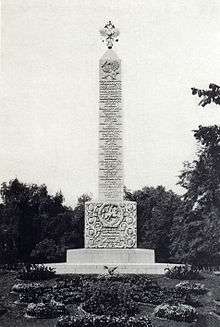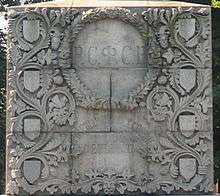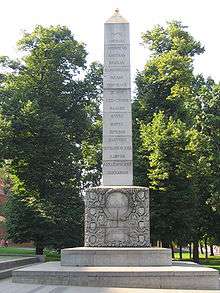Alexander Garden Obelisk
| Памятник-обелиск в Александровском саду | |
.jpg) Monument obelisk in 2013, after reconstruction | |
| Location | Alexander Garden, Moscow, Russia |
|---|---|
| Designer | S. A. Vlasev |
| Type | obelisk |
| Material | granite |
| Beginning date | Spring 1914 |
| Completion date | 10 July 1914 |
| Dedicated to | 300th anniversary of the Romanov dynasty |
Monument obelisk in the Alexander garden obelisk in Moscow, located in the Alexander Garden near the walls of Moscow Kremlin. Initial, so-called Romanovsky obelisk, was designed by S. A. Vlasev and erected on 10 July 1914 at the entrance to the garden (moved closer to the center of the garden in 1966) on the occasion of the previous year of the tercentenary of the House of Romanov.
Soon after the revolution by dismantling of parts, the drum fills of reliefs and counter-reliefs run was converted into a Monument-obelisk to outstanding thinkers and personalities of the struggle for liberation of workers, becoming the first monumental statue of the new state.
In 2013, the 400th anniversary of the Romanov dynasty, the monument was dismantled for the sake of creating a modern replica of the original monument to the Russian rulers of the Romanov dynasty, in this case, according to specialists, the original monument was almost lost.
Russian Empire
Made Vlasieva the project of the obelisk (under the motto "the Truth") earned the 2nd prize in 1912 a special contest "project of the monument-obelisk to commemorate the 300th anniversary of the Romanov dynasty", which was celebrated in 1913. Money for its construction "from the city" — up to 50 thousand rubles was allocated by the Moscow city Duma.
Since the initial plan did not cause the approval of the Academy of arts and Vlasyevo it took some time to correct the shortcomings, to direct work on the construction of the monument began only in the spring of 1914. The solemn ceremony of a bookmark, which was attended by representatives of various social classes[Comm 1], was held on 18 April 1914. During the laying of the first stone of the obelisk in it had a basis of V. D. Bryansk, the second A. A. Adrianov, the third Prince N. N. Odoevsky-Maslov, fourth Earl N. L. Ants and fifth — N. I. Guchkov. The ceremony was ended with the threefold singing of the national anthem of the Russian Empire.
June 10, 1914 was held the solemn opening of the monument (members of the Royal family it was not).
"Leading to the Alexandrovsky garden from Voskresenskaya Square gate and surrounding iron fence were decorated with national flags. Near the obelisk, closer to the Kremlin wall, there was a small elevation, beautifully draped with garlands of greenery; on the dais was placed Muscovites revered relic — the miraculous icon of the Iveron Mother of God. Along the entire length of the alley of the Boulevard stood the rows of cadets of the Alexander, Alexis and Tver cavalry school and part of the troops of the Moscow garrison with orchestra music.
.jpg)
At half-past eleven p.m. most Reverend Demetrius, Bishop of Mozhaysk, assisted by the Deputy spiritual Department in the City Duma Archpriest N. S. Vinogradov and other clergy have been done a thanksgiving with the blessing of water at slim the singing of the choir of the Cathedral of Christ the Savior. Before the end of the molieben his Eminence Dimitri spoke a word, which indicated a high significance of the monument erected, which is continually broadcast to the residents of the mother see of great service to Russia of the Reigning House of Romanov. The thanksgiving ended with the proclamation of many years to the Emperor, the Empress Empress, the crown Prince and Heir to the entire Russian Royal House and the eternal memory of resting in the Lord crowned members of the Romanov family. After that Bishop Demetrius sprinkled Holy water erected a monument on all four sides. The choir sang the national anthem. Then there was the parade were in the garden of the troops. The parade was commanded by commander of the 1st Grenadier brigade, major General Holmsen. Took the parade commander of the Moscow military district the General-of-cavalry P. A. Pleve, appearing in the middle of the front troops, proclaimed a toast for your Adored Sovereign Master of the Russian Land of the Emperor and the whole Reigning House. The troops, taking "on-guard", replied thunder, long smolkowski cheers; the orchestra played God save the Tsar! Then, General P. A. Pleve has declared a toast to the prosperity and welfare of the city of Moscow, built a glorious monument, "Wow Moscow!" — said General Plehve and in response to this there was a mighty Bang; the orchestra played the March of the Transfiguration. I. D. mayor, V. D. Bryansk on behalf of the city of Moscow thanked the General P. A. Pleve for proclaimed a toast. Then the troops were overlooked by the ceremonial March. General P. A. Pleve thanked valiant held a military unit" ("Moscow news" No. 134 – June 11, 1914).
Original appearance

The memorial was erected in the Upper Alexander garden near the main gate, leading from Voskresenskaya square in the Alexander garden.
The monument consists of two parts. Four-sided obelisk of Finnish granite was crowned double-headed eagle. At the top of the obelisk was placed the coat of arms of the Romanov boyars — a Griffin with sword and shield. Below were inscribed the names of the kings and emperors of the Romanov dynasty from Mikhail Fyodorovich to Nicholas II (except for Ivan VI Antonovich; after "of Empress Anna Ioannovna" comes after "Empress Elizabeth Petrovna"). The cubic base was a picture of George and the small coats of arms of provinces and regions of Russia in shields.
"Romanovsky obelisk is erected under the project of architect S. A. Vlasiev in that part of the Alexander garden, which is adjacent to the Voskresenskaya square. For setting the composition of the monument represents a cubic pedestal, on which stands the obelisk, ending in a gilt bronze double-headed eagle. The whole monument rests on two plateaus that are elevated at 0.60 fathoms above the surface of the earth. The monument is constructed from grey Finnish granite with embossed inscriptions, coats of arms and ornament. The upper part of monument (obelisk) is composed of seven monolithic granite pieces, and the lower one of granite facing slabs. The obelisk crowning the double-headed eagle is from cast bronze, chased and gilded. The inscription on the obelisk consists of names and patronymics of all the kings and Queens of the House of Romanov tercentenary in the past in chronological order, beginning with Tsar Mikhail Fedorovich and ending with the Name of the now reigning Sovereign of the Emperor. In the upper part of this inscription is placed coat of arms of the House of Romanov, on the pedestal is an inscription reading: "In memory of the 300th anniversary of the accession of the House of Romanov" and the coats of arms of Moscow, Kazan, Astrakhan, Poland, Siberia, hersenactiviteit, Georgian; the United coats of arms of the Grand Duchies of Kiev, Vladimir, Novgorod, arms of the Grand Duchy of Finland" ("Moscow news", No. 90 – April 19, 1914)
The Soviet period


Adopted after the October revolution Lenin's plan of monumental propaganda involved the demolition of "monuments in honor of tsars and their servants" (the decree of the CPC 12.04.18 G. "On removing monuments erected in honor of tsars and their servants and the elaboration of projects of monuments of Russian Socialist Revolution") and the construction of a large number of monuments and memorial plaques in honor of the fighters of the revolution of all times and peoples. The obelisk in the Alexander garden, without being physically liquidated, embodied both sides of Lenin's plan — he was turned into a monument to the leaders of the socialist and Communist thoughts and their precursors.
During August–September 1918 according to the decision of city Council Executive Committee dated 17 August 1918 under the direction of architect N. A. Vsevolozhsky, the obelisk was altered:
- the eagle from the peaks was filmed (with the help of the Latvian Riflemen)
- emblems with the Foundation were removed (cartouche and shields from the coats of arms preserved)
- in the Central cartouche, where the image of Saint George with the inscription "R. S. F. S. R." and "Proletarians of all countries, unite!")
- the names of the kings of the needle of the obelisk were shot down. In their place put a list of 19 social thinkers and political figures, approved by Lenin. The list of names was entrusted to a prominent Bolshevik V. M. friche.
The order of names is not chronological: the list of open Marx and Engels, followed by three of the founders of the German Social Democratic Party (1860 years) and then the figures of the social utopianism of the XVI and following centuries, are also a violation of chronology. The complete list of five names of Russians — representatives of different political currents, including subsequently the opposition to Bolshevism (for example, the populist N. K. Mikhailovsky, anarchist M. A. Bakunin and Menshevik G. V. Plekhanov). No name of the Bolshevik on the stele there (the list included only deceased figures, the last of them, Plekhanov, died the same year as the alteration of the monument). "Alteration of the monument was the actual and symbolic value: a revolution that destroyed the tsarist dynasty, destroyed the obelisk that is associated with the glorification of the dynasty, and erased all the names of its rulers" (the magazine of Art, 1939) "
The opening of the monument, called "Monument obelisk outstanding thinkers and personalities of the struggle for liberation of workers", was timed to coincide with the first anniversary of the Revolution and took place in October 1918.
Move
In 1966 the monument, originally located at the entrance to the Upper garden, was moved to the center of the Upper gardens to the grotto "Ruins" in connection with the construction of the memorial "Tomb of the Unknown Soldier".
Just at this place on 3 November 1918, the first anniversary of the Revolution, was established and stood for several days the concrete figure of Robespierre (work of sculptor B. J. Sandomirsky). But soon the monument was blown up by unknown persons — on 7 November the sculpture was found destroyed. "Northern commune" reported: "the Monument to Robespierre on the night of 6th to 7th of November had been destroyed by someone's criminal hand. The figure of Robespierre, made of concrete, turned into a pile of small fragments scattered around. The pedestal has survived. On a scene guard and put under investigation". However, another newspaper, "Izvestia", offered another version of the monument allegedly collapsed", due to improper location of the center of gravity of the whole figure of the monument is that it was noticed even when putting".
In our time

The proposal to restore Romanovsky obelisk in its original form to the 400th anniversary of the Romanov house have repeatedly heard from members of the public, in particular, the Fund's "Return". In the beginning of 2013 Vice-President of Fund "Return" on legal issues Daniel Petrov said that "another appeal of Fund "Return" on Romanovsky obelisk, mutilated by Bolsheviks and standing in the Alexander garden near the Kremlin wall, finally, gave a preliminary result. The Ministry of culture is ready to consider returning the monument to its historic appearance". According to him, now "the Ministry needs ALL the documentary and historical materials on this monument, including local literature in Moscow". In this regard, he urged Russian historians and ethnographers to connect to this work, and "if anyone has materials on this subject (articles in books, guidebooks, photos before 1918 and after), etc., I am grateful for their sending me to message the Ministry of culture". May 27, 2013 in the Alexander garden, on visual axis "Manezhnaya Square, the obelisk is the grotto" was erected an entirely new monument to Patriarch Hermogenes. After nearly a month, 2 July 2013, the obelisk was dismantled for reconstruction, without prior announcement, which caused questions from some residents about his fate. The press-Secretary of Department of presidential Affairs Viktor Khrekov explained that the monument will return to my place by 4 November. According to him, the obelisk was dismantled, because "when you transfer to a new place in Soviet times, mistakes were made, which further has led to the fact that the obelisk tilted and began to pose a serious threat to people". A special working group under the Ministry of culture came to the conclusion that the monument was "necessary to restore and strengthen the foundations". The restoration of the obelisk has been the company "Alfastroy" not having the proper license. For the restoration of the monument was found Karelian marble that was originally used to create the obelisk.

At the end of October 2013, the restored monument began to mount. Sculptor Nikolai Avvakumov found that when the restoration of mistakes and inaccuracies. In particular, the inscriptions were made standard font Izhitsa Cyrillic, while in some words there is a spelling error; the reconstructed image also does not correspond to the original. At the same time, the photographs of the monument, common on the opening day, November 4, 2013, two of the Avvakumov spelling errors have been fixed (hard sign in the word "memory" has been replaced with soft, added existed in the original text the hyphen in the word "300th anniversary").
Public movement "Arhnadzor" declared that "the restoration of the obelisk took place without any open expert and public discussion of its plan and project", in the end, "the original of 1914 has not been raised, and the original 1918 died in Alexander garden is now showing off a replica, not a monument of any era." Later "Arhnadzor" declared that "carried out in 2013 on the obelisk of work cannot be called restoration."
In the culture

- Soviet school book to read — A. P. Shikman, "Obelisk in Alexandrovsky garden: lives of the great socialists" (1990) consisted of biographical essays about people whose names were carved on the obelisk.
- D. W. Gross, G. E. Lapshina. "The names on the obelisk" (1981) — a similar collection.
Полужирное начертание
Coordinates: 55°45′13″N 37°36′54″E / 55.7537°N 37.6149°E